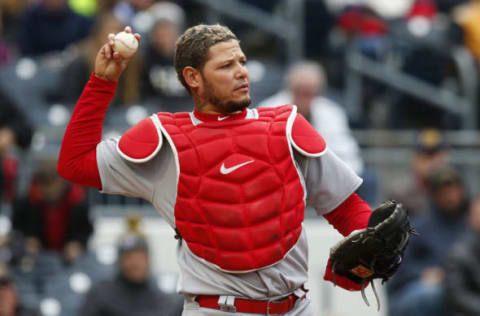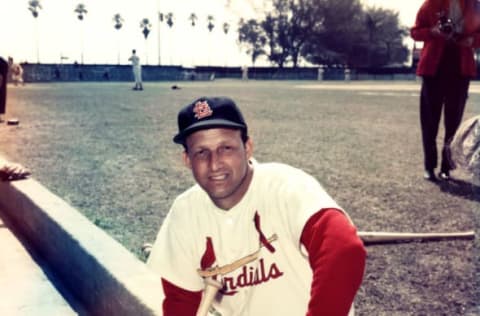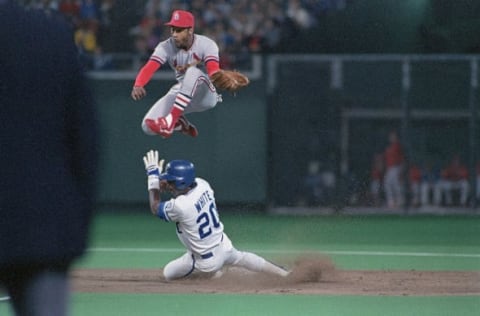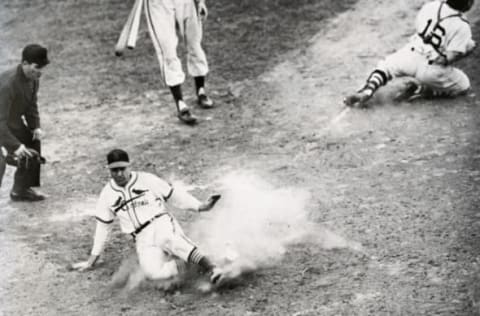St. Louis Cardinals: Yadier Molina joins exclusive club


St. Louis Cardinals catcher Yadier Molina has joined some exclusive company.
Yadier Molina became the fifth player in St. Louis Cardinals history to play in 1800 games with the franchise.
With his 1800th game as a St. Louis Cardinal under his belt, Yadier Molina has joined an exclusive club. He is just the fifth Cardinal to play 1800 or more games with the team. He joins Stan Musial, Lou Brock, Ozzie Smith and Enos Slaughter as the only players to do this. Those four players are in the Baseball Hall of Fame.
Molina was drafted by the Cardinals in the fourth round of the 2000 Amateur Draft. Eight picks before him, the Montreal Expos took Cliff Lee. Another longtime MLB player taken in the fourth round of that draft was David DeJesus. Lee last played in the big leagues in 2014. DeJesus hasn’t appeared in a game since 2015.
For the first seven years of his career, Molina was the epitome of the good glove, no-hit backstop. He had a .268/.327/.361 batting line and averaged six home runs and 46 RBI in 115 games per season. While the bat wasn’t impressive, the glove was. He won three Gold Glove Awards and made the all-star team twice in his first seven years.
Molina has added five more Gold Glove Awards and six more all-star appearances to his resume. He also picked it up with the bat, starting with the 2011 season when he went on a three-year hitting binge. From 2011 to 2013, Molina upped his power output to an average of 16 home runs per season in 138 games while hitting .313/.361/.481.
Then, just as suddenly as he made the great leap offensively, he dropped back to roughly a league average hitter. In the last four-plus seasons, he’s been right at league average with a .282/.327/.409 batting line. He’s enjoyed the home run surge over the last few years, though, as he hit 18 last year and has 11 at the halfway point this year. His on-base percentage hasn’t kept pace (.310 OBP since the beginning of the 2017 season).
Unlike the other four Cardinals who’ve played 1800 or more games with the team, Molina still has a ways to go to get to the Hall of Fame. On the Jay Jaffe JAWS Hall of Fame monitor, he’s very close to Hall of Famer Roy Campanella, but Campy isn’t a good comp. His career was cut short by the color barrier on the front end and a car accident that left him with a spinal cord injury on the back end. He also won three MVP Awards.
Molina is 35 years old and still about 15 Wins Above Replacement (WAR) short of the average Hall of Fame catcher. He also doesn’t have the peak that Hall of Fame catchers have. Molina has had just two seasons in which he was worth more than 3.5 WAR.
Even if he doesn’t make the Hall of Fame, Molina has had a terrific career. With two more years left on his contract with the Cardinals, he has a good chance to get to 2000 hits. He’s at 1779 right now. Should he get to 2000 hits, he would be one of six St. Louis Cardinals players to do so. He would also be only the 16th catcher in baseball history to get there.
So what about the other four Cardinals players who have played 1800 games with the franchise? Let’s take a look at this iconic foursome.

Stan Musial—3026 games with the Cardinals
Stan Musial is not only one of five players to appear in 1800 games with the Cardinals; he’s also one of only two players to appear in 2000 games with the Cardinals. In fact, he’s all by himself as the only player to appear in 3000 games with the Cardinals. He played in 3026 games in his career, tied with Eddie Murray for the sixth-most games played in the history of baseball.
Musial was “The Man” in St. Louis. He played 22 years in the major leagues, all with the Cardinals. Only once, in his final season when he was 42 years old, did he have a below average season on offense (98 wRC+). Even then, he was above replacement level (1.3 WAR).
More typical for Musial was the 16-season stretch from 1942 to 1958 (minus 1945 because of World War II) during which he averaged 7.4 WAR per season. In more than 2400 games in this period, Musial hit .340/.426/.578 with season averages of 150 games played, 107 runs scored, 25 homers, and 102 RBI. He was as consistent a hitter as you’d ever want to see.
Current baseball fans might not know that Musial was a pitcher before becoming a Hall of Fame hitter. Before reaching the major leagues, he spent his final full season in the minor leagues both pitching and hitting. On the mound, he was 18-5 with a 2.62 ERA in 223 innings. With the bat, he hit .311 with a .410 slugging percentage in 405 at-bats. His pitching career ended after he made a diving catch while playing the outfield and injured his shoulder.
A dozen years later, Musial made one appearance on the pitching mound in the major leagues. On the final day of the 1952 season, he was brought in to face Frank Baumholtz, who was trailing him in the batting race. Musial threw one pitch and Baumholtz grounded to third, but third baseman Solly Hemus bobbled the ball and Baumholtz reached on an error. That was it for Musial’s major league pitching career: one pitch.
As good as he was on the field, Musial may have been even better as a person off the field. He was beloved all around baseball but especially in St. Louis. I’d argue he is the greatest first baseman who ever played the game. He was also one of the greatest people to ever play the game.

Lou Brock—2289 games with the Cardinals
Second on the all-time list for games played with the St. Louis cardinals is base-stealing left fielder Lou Brock. Brock wasn’t a lifetime Cardinal. He played 327 games with the Cubs before the infamous trade of Brock for Broglio transpired in June of 1964. The trade involved a handful of other players, but it was mainly Brock for Broglio.
In the three-and-a-half seasons Brock played with the Cubs, he was not yet the prolific base stealer he would become. His single-season high with the Cubs was 24 steals. In his first full season with the Cardinals, Brock stole 63 bases, which was a preview of what was yet to come.
From 1965 to 1977, Brock averaged 63 steals per season. He led the league eight times in this 13-year stretch. He also averaged 97 runs scored per season and twice led the league in that category. He was a five-time all-star.
Brock was at his best in 1967 and 1968 when he had back-to-back seasons with 5.6 and 5.8 WAR, but his most famous season was 1974. That year, he broke Maury Wills’ single-season stolen base mark when he nabbed 118 bases (Wills had 104 in 1962).
Brock’s record has since been broken by Rickey Henderson, who was recently named the third greatest left fielder in the history of baseball here at Call to the Pen. Henderson stole 130 in 1982. Brock remains second on the all-time single-season steals list.
Even though he played the second most games in St. Louis Cardinals history, Lou Brock is barely in the top 10 in WAR for the franchise. His defense brings him down and he had a fairly low walk rate. His .297 batting average is very close to the “magic” .300 average that was long considered the gold standard. That said, his .347 on-base percentage is 54th among the 96 Cardinals with more than 2000 plate appearances.
Brock made the Hall of Fame in his first year of eligibility but is well below the average of 20 Hall of Fame left fielders using Jay Jaffe’s JAWS metric. One reason he made the Hall of Fame was likely his 3023 hits. Also, he was the all-time leader in stolen bases for many years after he retired.

Ozzie Smith—1990 games with the Cardinals
Like Lou Brock, Ozzie Smith played for another team before coming to the Cardinals. Smith was a light-hitting, good-gloved shortstop in San Diego for four seasons. It was in his last two years with the Padres that he started his string of 13 consecutive Gold Glove Awards.
Prior to the 1982 season, Smith was traded by San Diego along with Steve Mura and a player to be named later to the St. Louis Cardinals for Garry Templeton, Sixto Lezcano and a player to be named later. Smith and Templeton were both shortstops and the main players in the deal.
Smith made the all-star team for the first time in his final season in San Diego, then made it 14 times in his 15 years with the Cardinals. From 1982 to 1993, he was worth an average of 5.2 WAR while stealing 35 bases per season with a .353 OBP. He was never a top offensive player, but he held his own with the bat and was terrific in the glove. He’s considered by many to be the greatest fielder in baseball history.
The Cardinals made the playoffs four times while Smith was on the roster. Three of those four times they made the World Series. In 1982, they beat the Milwaukee Brewers in seven games. They also lost two heartbreaking seven-game series in 1985 and 1987. One of the iconic moments of Smith’s career was his walk-off homer in Game 5 of the 1985 NLCS. Go crazy, folks, go crazy!
Along with the tremendous plays he made in the field, Smith was a joy to watch for baseball fans. He had his trademark backflip and his always-present smile. His glove made the highlight reels but he also turned himself into a solid hitter for a good decade in the middle of his career. His offense and defense combined were valuable enough to land him at number six on the list of the best shortstops in MLB history.

Enos “Country” Slaughter—1820 games with the Cardinals
Enos Slaughter got the nickname “Country” when he was in the minor leagues. The story goes that when his manager in Double-A, Burt Shotton, first saw Slaughter, he immediately called him “Country” because of his tight-fitting clothes, red face, and straw-colored hair. “Country” hit .382 that year.
A season later, the 22-year-old Slaughter was in the major leagues. He played 112 games in his rookie year of 1938 and was worth just 1.0 WAR, but would average 4.4 WAR per year over the next four seasons. In 1941 and 1942, he made the NL All-Star team. He also finished second in NL MVP voting in 1942, behind teammate Mort Cooper.
In the postseason, the Cardinals squared off against the New York Yankees in the World Series. The Yankees had won five of the six previous World Series, but the Cardinals took them down in five games. Slaughter hit .263/.364/.474. That’s pretty good, but he would have his iconic moment in the World Series four years later.
In the meantime, Slaughter missed the next three seasons while serving in World War II. He came back in 1946 to continue his string of all-star seasons. He made the all-star team 10 times in his 13 years with the Cardinals. In 1946, he led the NL in games played and RBI and finished third in NL MVP voting.
Slaughter’s famous moment, known as the “Mad Dash,” came in the seventh game of the 1946 World Series. With the score tied against the Boston Red Sox, he led off the bottom of the eighth with a single to center. The next two batters were put out and Harry “The Hat” Walker stepped to the dish. He lined a ball in the left-center gap.
Slaughter was off on the pitch and galloping around the bases. The Red Sox’ starting centerfielder, Dom DiMaggio, had pulled a hamstring in the top of the inning. His replacement was Leon Culberson. As Slaughter charged around the bases, Culberson retrieved the ball and threw it to shortstop Johnny Pesky.
The third base coach had the stop sign up, but Slaughter ran right through it and bolted for home. Pesky hesitated for just a second before firing to the catcher and the throw was late. Slaughter had scored from first to put the Cardinals ahead. The Red Sox put two runners on base in the top of the ninth but Roy Partee and Tom McBride couldn’t score them and the Cardinals had their World Series rings. Slaughter hit .320/.433/.560 in the series.
Over the next seven years, Slaughter continued to have all-star seasons for the Cardinals. He wasn’t a big time home run hitter but he regularly scored 80 to 100 runs per year and drove in 90 or more runs seven times while with the team. In 1954, he was traded to the New York Yankees. He played six more years in the big leagues, five with the Yankees and one with the Kansas City Athletics.
Red Schoendienst—1795 games with the Cardinals
The late Red Schoendienst almost made this list. He played in 1795 games with the team, but was an iconic figure in St. Louis for decades so he’s well deserving of a mention. He was part of the organization for 67 years as a player, coach, manager and roving instructor. His story is like something out of an old time movie.
When he was 19 years old, he and a couple buddies hitched a ride to St. Louis to try out for the Cardinals. They were one of 400 men to show up. Schoendienst was sent home at the end of the week but the Cardinals head scout, Joe Mathes, who had left camp early, made sure to sign Schoendienst shortly after he realized the team had let him get away. His first professional assignment was in Union City, Tennessee, in the Class D Kitty League.
Three years later, Schoendienst was a rookie in St. Louis leading the NL in steals. The next season he was an all-star for the first of 10 times. He played 15 years with the Cardinals and is sixth all-time in games played and hits for the franchise. He also played four years with the Milwaukee Braves and two with the New York Giants.
Next: Carpenter's record breaking night
In 1969, Schoendienst was selected to the Baseball Hall of Fame by the Veteran’s Committee. The Cardinals honored him in 1996 by retiring his jersey number 2. Three years later, a statue of him was unveiled at Busch Memorial Stadium. Upon his death recently, Cardinals owner Bill DeWitt Jr. said in a statement, “His influence on this organization cannot be overstated. Red was a great player, a great manager, and a wonderful mentor to countless players, coaches, and members of the front office.”